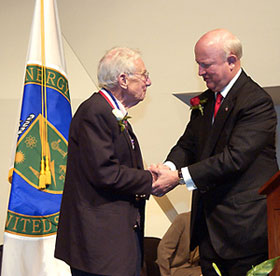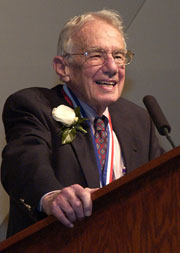June 22, 2006
Enrico Fermi Award Ceremony
Remarks Prepared for Energy Secretary Samuel Bodman
| |
 |
| |
Secretary Bodman (right) congratulates Art Rosenfeld, winner of the Enrico Fermi Award. | The Department of Energy has a very rich scientific tradition and one of the best things about being Energy Secretary is from time to time I have an opportunity to acknowledge that tradition and the very real impact it continues to have on the lives of all Americans.Today is one of those days.
We are here to honor Art Rosenfeld with our nation’s highest scientific honor: the Enrico Fermi award recognizing a lifetime of highly relevant and public-spirited work in the cause of energy efficiency as well as pioneering discoveries in experimental and particle physics and the generosity of spirit and intellectual rigor with which he has carried it all out.
Art, we are proud of you for what you have done, and when I say we, I mean Roz, your daughter, Anne, and your many friends and colleagues who are here with you to take part in this ceremony and celebration. We are also grateful to you, and this award represents our thanks for all that you have done for us.
Somehow, when America faces a pressing national need, the right people step forward to help meet it.
That was certainly the case in 1973, when amid the anxieties of a national energy crisis, Art Rosenfeld changed course from a brilliant career in basic research in particle physics and focused all of his intellectual energy and leadership skills on solving the puzzle of where the energy we were collectively using was going.
During his years as a physics researcher, Art published a very valuable guide for his colleagues that compiled all the data available on the measurements of elementary particles.
Physicists all over the world carried pocket copies of his guide—often in their wallets—and relied on it heavily in their work. The guides had a more formal name but were commonly known as The Rosenfeld Tables. I believe this was the first sign that Art’s name would acquire a wider meaning, but there was more to come.
After Art moved to address the problems of achieving more efficient use of energy in the U.S., a new fundamental principle began to emerge . . . The Rosenfeld Effect. I understand this was even the theme of the party many of you threw for Art two months ago to celebrate the rather serious birthday he is facing tomorrow.
 |
|
Art Rosenfeld | I define The Rosenfeld Effect as the magnetic pull that one man’s energy and passion for a cause can exert on all those who come in contact with him.
The Rosenfeld Effect led directly to The Rosenfeld Efficiency Factor—that is the amount of energy saved through the many energy efficiency initiatives that have worked their way through our economy over the last 30 years—usually with prodding or backing from Art.
One of Art’s friends at the Environmental Protection Agency—Art, it seems, has friends in most federal agencies as well as in many out of the way places around the globe—has done some calculations on this and estimates that energy efficiency programs adopted between 1973 and 2005 have held the nation’s use of electricity to a level 21 quads below what it otherwise would have been.
For those of you unfamiliar with energy speak, a quad is a quadrillion BTUs of energy. It is a very big number. Saving that amount of energy at 2005 prices was worth $228 billion to the U.S. economy.
Some of the biggest savings have come from efficiency gains in how we heat, light and cool our buildings and run our appliances. These systems absorb almost 40 percent of the energy we consume in the U.S. and account for 80 percent of what we spend on electricity.
Running them more efficiently has made it possible for our economy and our population to continue to grow without sending our energy costs and usage to levels that we could not afford, either economically or environmentally.
Art has been a leader in nearly all of these efforts. Since he signed on in 1973, the progress in this field has been dramatic.
In 1975, Art founded what eventually became the Center for Building Science at Lawrence Berkeley National Laboratory and began assembling a top-notch team of researchers who were as dedicated to the cause of efficiency as he was.
Art served as both the visionary leader for the center and a frequent co-conspirator in framing the technical details of the research done there. Perhaps his most important contribution was the inexhaustible supply of optimism and enthusiasm he brought to the cause.
The record speaks for itself. During the 1970s and 1980s the center developed high-frequency, solid-state ballasts for fluorescent lights that made them more efficient and led to the development of compact fluorescent lights.
The center also developed low emissivity metallic oxide coatings for windows that let light in while keeping heat in or out, depending on the season. These innovations have been widely adopted by the private sector.
A study by the U.S. National Research Council in 2001 concluded these innovations delivered $23 billion in net economic benefits to the nation between 1978 and 2000.
Art took a direct role in other innovations that came out of the Center, such as the DOE-2 software that promoted more energy efficient building designs and the research work that established the efficacy of lighter colored roofing in deflecting heat.
But perhaps Art’s greatest contribution has been in framing the questions and developing the analytical and conceptual tools that have provided the intellectual underpinning for the entire field of energy efficiency research. This was vital, ground breaking work. Art’s contributions have set the foundation that future generations of scientists and engineers will build upon.
His tools have also helped make a persuasive economic case to the private sector for investing in more efficient equipment and buildings. And Art was one of the first to focus on ways to provide utilities with profit incentives for operating more efficiently.
In the public arena, both at the Energy Department in Washington and at the California Energy Commission in Sacramento, where Art is now in his second term, he has proven himself an adroit policy maker known for using common sense and data to make his case.
Art has fought many battles on behalf of efficiency and has weathered his share of setbacks. None have deterred him for long or dented his certainty about the eventual outcome. There is plenty more to be done. And Art, even though this is a lifetime honor, we aren’t about to let you quit and rest on your laurels.
The spike in the world price of oil we have all had to endure over the last year has made it clearer than ever that continued gains in energy efficiency and conservation in all sectors are vital to both our national security and economic strength.
Art is the first scientist to receive this award for work outside the field of nuclear energy which Enrico Fermi helped pioneer. But, as you know, Art falls firmly within the Fermi tradition in many ways. Like Fermi, Art has seamlessly combined the theoretical and the practical in his career. And he has devoted his energies to a field that has had a profound impact on our society.
Art, you have strengthened our nation and the world through your work. You are truly a worthy recipient of the Enrico Fermi award.
And now I’d like to invite Art Rosenfeld to step forward to receive his award.
On behalf of the President of the United States, it is my pleasure to present the 2005 Enrico Fermi Award to Arthur Rosenfeld “for a lifetime of achievement ranging from pioneering scientific discoveries in experimental nuclear and particle physics to innovations in science, technology, and public policy for energy conservation that continue to benefit humanity.”
Congratulations, Art.
Location:
Washington, DC
Media contact(s):
Craig Stevens, (202) 586-4940
|